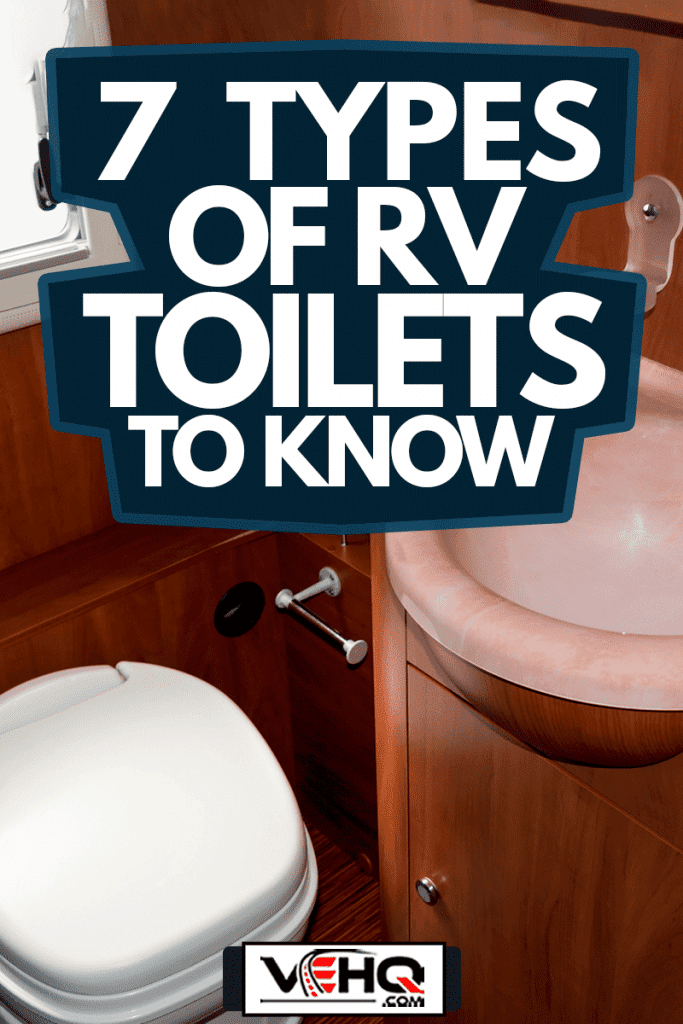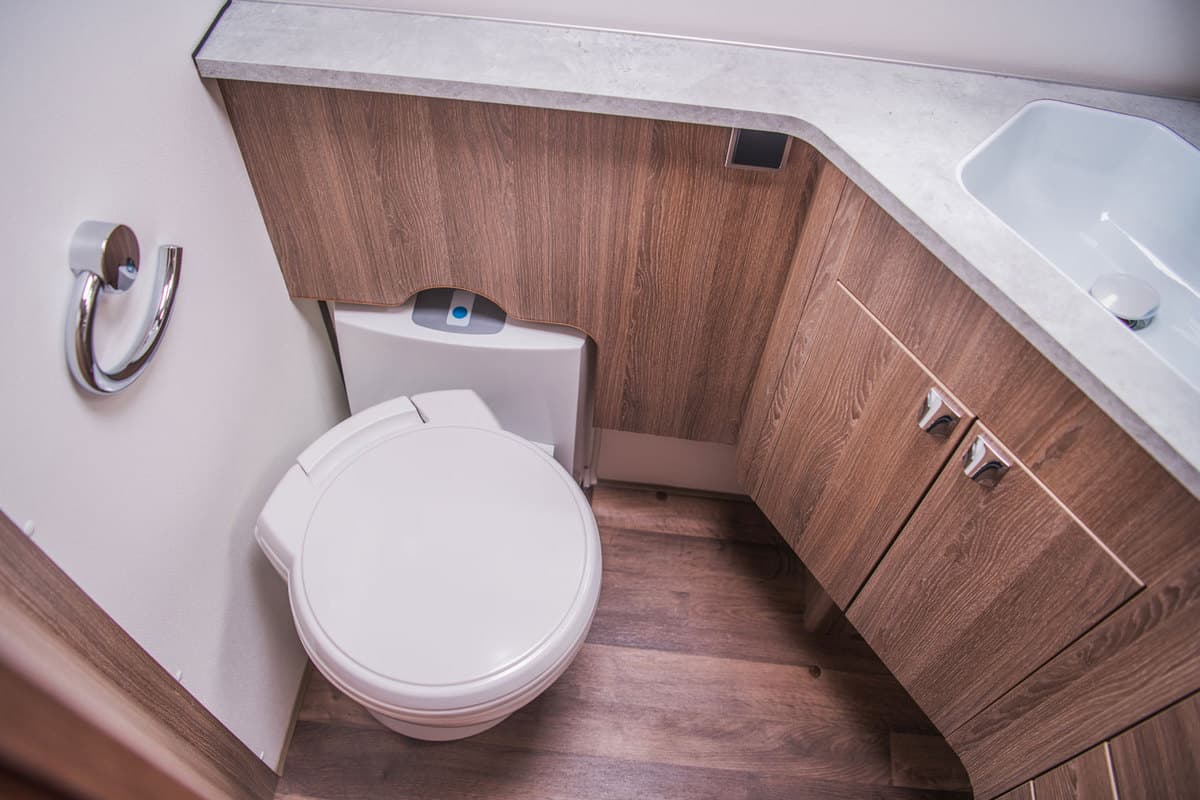When you are on the road and nature calls, you'll want to have the best RV toilet for your needs on deck. But, what is the right type of RV toilet for you? We covered different types of popular commode choices, ranging from incinerating to dry-flush products. In this post, we will help you find the right toilet for your RV.
Maintaining your hygiene and privacy by selecting a toilet to accommodate you when you need to go is of the highest importance. Here are seven types of RV toilets to choose from:
- Plastic gravity flush or porcelain gravity flush
- Dry flush
- Macerating
- Portable
- Incinerator
- Composting
- Cassette
RVs allow you the creature comforts of home while allowing you to focus on exploring the great unknown. Depending on how you feel about handling waste products, how often toilets on RVs require cleaning and maintenance, and your budget, the right type of toilet for your needs is available. Read on to learn more about different toilet options, unique features, and the pros and cons of each.

[toc]
7 Types of RV Toilets to Know

1. a. Gravity Flush (Plastic)
If you are lucky enough to have a larger RV, a gravity flush toilet is the most common toilet type. Note, this type of toilet is similar to flush toilets in homes, except it is directly plugged into the black tank to allow gravity to take care of waste. The toilet is connected to the water supply but uses less than 0.3 gallons per flush.
When flushing, it may need an additional amount of water to help keep it clean. Plastic is an inexpensive option that is lightweight and may fade. But, it is less likely to break compared to porcelain, depending on the quality. Because the toilet is plastic, it may be tricky getting waste to not stick in the bowl when flushing.
Pros
- Lightweight
- An inexpensive option
- It uses less water than residential toilets
- It doesn't break as easily as porcelain
Cons
- More difficult to keep clean
- May need more water than a porcelain toilet
Check out this plastic gravity flush toilet on Amazon.
1. b. Gravity Flush (Porcelain)
If you can spend a bit more on an RV toilet, a porcelain gravity flush commode tends to be more comfortable and better made than its plastic version. You can enjoy a flush toilet with an elongated bowl, and the interior is easier to clean and resists waste sticking compared to plastic. However, porcelain may be more likely to get damaged on the road and may require more space.
Pros
- More comfortable seating and support
- It holds its shape and resists fading and peeling
- It looks more like a house toilet
- Easier to keep clean
Cons
- More expensive than plastic
- Better suited for larger RV bathrooms
2. Dry Flush
If you don't mind a little extra maintenance and want to go around using a sewage hookup, a dry flush toilet is helpful. This style of commode requires a bag to line the bowl but doesn't need water or chemicals to take care of waste. After you flush the toilet, any waste is compressed and sealed inside the bag to prevent odors or leakage.
Once the capacity is reached, you empty out the commode. Typically, this type of toilet is battery-operated and portable.
Pros
- Portable and lightweight
- It doesn't require hooking up to sewage or plumbing outlets
- Battery operated
- No chemicals, water, or odors
Cons
- Bags for waste are usually not able to be composted
Check out this waterless toilet on Amazon.
3. Macerating
Choose this type of toilet if you want to minimize problems with clogs from toilet paper and waste. After flushing the toilet, waste is sent upward and shredded into a manageable slurry. The slurry is then sent to a sanitary container until it is emptied.
Because this type of toilet requires electricity to power the macerating mechanism, it may be noisy at night and is usually expensive. Caution should be taken not to flush anything down the toilet that can damage parts or break the toilet.
Pros
- Maceration reduces clogs caused by toilet paper
- Conveniently stores waste and makes for easy removal
- A good alternative for a gravity flush toilet
- Requires minimal water
- A good option for a second toilet
Cons
- Expensive to repair or replace parts
Check out this macerating toilet on Amazon.
4. Portable
If you are bringing a portable toilet along for the ride in an RV, you'll need to anchor it down with a kit. Kits come separate from your toilet and will help prevent unwanted spills, tipping incidents, and allow for a more comfortable experience. These types of toilets often come with multiple compartments for holding waste, water, and the toilet bowl.
A chemical added to the toilet tank helps break down waste and reduce odors. Note, this style of toilet will need to be emptied out frequently. However, it can be used on an RV, outside when camping, or anywhere it is needed. It does not need to be hooked up to any plumbing and is an inexpensive option.
Pros
- Environmentally-sound and budget-friendly
- Lightweight and portable
- Available in dry flush or with water flush
- A good option for smaller, odd-sized RV bathrooms and small groups
Cons
- Requires frequent emptying
- The need to purchase a kit to anchor the toilet
Check out this portable toilet on Amazon.
5. Incinerator
Say goodbye to dealing with dump stations, accidents with spilled waste, or messy cleanups of your RV toilet. An incinerator toilet doesn't require a plumbing hookup or water and is practically odorless. When you need to flush the toilet, at the push of a button, waste is quickly and effectively rendered into ash.
Typically, incinerator toilets are small in size and can be easily moved about an RV bathroom. Also, these types of toilets are powered by either gas or electricity. Next to portable toilets, this is an excellent option if you are out in the country and nowhere near a campground dumping station.
Pros
- Environmentally friendly waste disposal
- Powered by propane gas or electricity
- No need for water or black tanks
- Practically odorless
Cons
- Energy cost is high
- No ability to compost waste
6. Composting
Be more environmentally friendly and safely transform human waste into night soil with a composting toilet. Although this style of toilet may require electricity to operate and may emit slight odors, it is usually a space-saving option. Some toilets are slow composting and need peat moss or sawdust.
Thankfully, you don't have to clean this type of toilet often if you have a small group. You can avoid the need to rely on water or a flush toilet and use a composting toilet in your RV bathroom. Plus, it is easy to install, use, and maintain. There are usually two different compartments to handle liquid and solid waste without problems.
Pros
- Often has separate compartments for liquid and solid waste
- Environmentally-friendly
- A good option for small groups and user-friendly
- Inexpensive and easy to install
- A water-less option that doesn't need plumbing
Cons
- Not always a practical option
- May require electricity to function
Check out this composting toilet on Amazon.
7. Cassette
Cassette toilets are usually more popular in Europe compared to America. They are comparable to a gravity flush toilet, except that they include a removable holding tank for easy waste removal in public toilets. However, because this style of toilet isn't hooked up to plumbing, so you need a dumping station, prepare to empty it more often.
If lifting is a challenge, you may want to pass up on this toilet because of potential challenges with waste removal. Although the waste tank may come with handles or wheels to help move it around, you may need assistance.
Pros
- Includes a removable waste tank for easy dumping
- It doesn't require hooking up to a dumping station
- Fewer odors than toilets with a fixed black tank
Cons
- Can fill up quickly and require frequent dumping
- Waste removal may get awkward
How Do I Know What Kind Of RV Toilet I Have?
Most commodes have a label on their backside, displaying the model information. Some toilets will lack any hookup for water or sewage and contain drawers with separate compartments. Look for your owner's manual or take a picture to run it through an app to verify your RV toilet identity.
Gravity flush toilets look like typical toilets in a home but lack a water tank at the back. Portable toilets often have a more bucket-style appearance. Incinerating toilets and some composting toilets look similar in appearance. Cassette toilets have a detachable tank for waste.
Can You Upgrade Your RV Toilet?
The toilets used in homes cannot be interchanged with those in RV because of plumbing and access to a constant sanitary water main being an issue. However, it is possible to upgrade your RV toilet.
One of the easiest options is to install an incinerating or composting toilet, which doesn't require any water. Another popular choice is a porcelain RV toilet to give your on-the-road bathroom a more homey feel and look.
Before upgrading your RV toilet, know your need for personal comfort, the toilet's capacity for waste, and durability. Porcelain toilets are usually not ideal for RV life because of frequent jostling about from potholes and road hazards. Also, traditional toilets that are heavy and dependent on water can be problematic over time.
How Much Does It Cost To Replace An RV Toilet?
The cost of replacing an RV toilet might run you as much as a new toilet in and of itself. However, if you are feeling sticker shock, try your hand at replacing an RV toilet without hiring professional help. Labor costs are usually around $100 an hour. The cost to put in an RV sewer hook-up might be as much as $2,000 to $3,000.
The cost of RV repairs runs an average between $65 and $189 an hour for labor, not including parts. Based on how much you pay for your new RV toilet and any other necessary work, prepare to invest a small chunk of change. If you feel brave enough to change an RV toilet, it usually requires removing only two main bolts, some cleanup, and repositioning a new commode.
In Closing
We hope you take away from this post a deeper understanding of RV toilets, their unique features, and their benefits. No matter your budget or lifestyle, you can choose from a dry flush composting toilet, cassette-style of commode, or a gravity flush device.
As outdoor living and RVs increase in popularity, having a quality, durable toilet that can handle heavy-duty loads when nature calls is imperative. Find the best RV toilet to fit your lifestyle.
Before you leave, you won't want to miss checking out the following articles of interest:
9 Best RV Toilet Cleaners For Any Rig [Motorhomes, travel trailers etc.]





